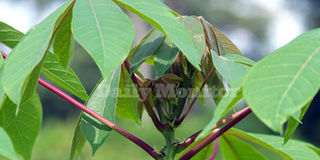Are cassava leaves poisonous in pig feeding?

Cassava leaves. The money is expected to boost agricultural production. PHOTO/NMG.
I fed my pigs on these cassava leaves in the morning. A few minutes later I found one dead with a swollen tummy and the other struggling for life. Is the cassava poisonous? They were clearly fine before I fed them. Mikhail Wilson
Dear Wilson (Answered by Samson Obong, an agronomist at Ngetta Zonal Agricultural Research Development Institute (Ngetta ZARDI)
Fresh cassava leaves can safely be fed to growing pigs at levels up to about 25 per cent of the diet.
But in fresh cassava leaves, there is a high content of glucosides, linamarin and lotaustralin, which are hydrolysed by the linamarase enzyme, resulting in the release of hydrocyanic acid (HCN), which is toxic to the animal.
HCN is colourless, volatile and extremely poisonous. The content of HCN in cassava differs among varieties and generally ranges from 200 to 800 mg/kg in the fresh leaf.
The glucoside concentration in cassava leaves decreases with age. The elimination of cyanogens by heating will depend on the temperature, the stage of development of the plant, and the type of heat. Simple sun drying or oven drying can eliminate almost 90 per cent and sun drying reduces the cyanogen content of cassava leaf more effectively than ensiling. Research has concluded that despite its high content of HCN, documented cases of poisoning due to the ingestion of cassava leaf are rare.




